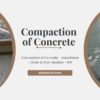This article delves into ten practical tips to enhance the efficiency of the concreting process, ensuring projects are completed on time, within budget, and to the highest standards.
From embracing modern technology to adopting time-tested techniques, these tips are designed to streamline the concreting process. Whether you’re a seasoned professional or new to the field, these insights will help you optimise your concreting operations.

1. Pre-Planning and Site Preparation
Efficient concreting starts well before the concrete is mixed. Comprehensive pre-planning involves a detailed analysis of the project requirements, including understanding the specific needs of the site.
This step includes assessing access routes for material delivery, preparing the ground for concreting, and ensuring that all necessary tools and equipment are on hand. Effective site preparation minimizes potential obstacles, ensuring a smoother and faster concreting process.
2. Quality Control of Materials
The integrity of concrete is heavily dependent on the quality of its components. It’s essential to source high-quality cement, aggregates, and water, and to consistently test these materials for purity and performance.
Regular quality checks help in maintaining consistency in the concrete mix, leading to better workability, strength, and durability. This proactive approach to quality control can prevent costly rework and delays.
3. Optimal Water-Cement Ratio
The water-cement ratio is a critical factor in determining the quality of concrete. An optimal ratio ensures the mix is workable yet strong. Over-watering leads to weaker concrete, while too little water makes the mix difficult to work with and can compromise structural integrity.
Understanding the specific requirements of your project and adjusting the water-cement ratio accordingly is key to producing high-quality concrete.
4. Use of Modern Mixing Techniques
Leveraging modern mixing technologies can significantly enhance the efficiency and quality of the concrete mix. Advanced mixers provide a more uniform and consistent mix, reducing the likelihood of weak spots in the concrete. These mixers also speed up the mixing process, allowing for quicker turnaround times on site.
5. Efficient Transportation and Handling
The method of transporting and handling concrete is crucial in maintaining its quality. Utilizing efficient transportation methods is essential to prevent segregation and preserve the mix’s properties.
This includes choosing the right mode of transportation and ensuring that the handling process is as quick and smooth as possible to maintain the integrity of the concrete.
6. Proper Compaction
Proper compaction is vital for eliminating air pockets and ensuring the concrete is densely packed, which is essential for its strength and durability. Using the right compaction equipment and techniques is crucial.
This step requires understanding the type of concrete being used and the specific requirements of the project to choose the most effective compaction method.
7. Monitoring Concrete Temperature and Humidity
The curing process of concrete is significantly influenced by environmental factors such as temperature and humidity. Actively monitoring these conditions and adjusting curing practices accordingly can prevent common issues like cracking. This proactive approach ensures the concrete achieves its maximum strength and durability.
8. Use of Sensors for Real-Time Data
Incorporating advanced sensor technology, like the systems offered by Converge, provides invaluable real-time data on the concrete’s strength and curing conditions.
This technology enables more precise and timely decision-making, optimizing the curing process and reducing the reliance on estimates and assumptions.
9. Timely Curing
Timely and appropriate curing is crucial for the development of concrete strength. The curing process should be tailored to the specific type of concrete used and the environmental conditions.
Proper curing ensures the concrete reaches its intended strength and durability, which is essential for the longevity and safety of the structure.
10. Regular Training and Skill Upgradation
The efficiency and quality of the concreting process are heavily dependent on the skills and knowledge of the workforce. Regular training and skill development ensure that the team is equipped to handle the latest equipment and techniques. Investing in the workforce’s development leads to more efficient, effective, and safe concreting practices.
Things to keep in mind
Improving the efficiency of the concreting process is a multifaceted approach that involves careful planning, quality control, and the adoption of modern technologies and techniques.
By implementing these ten tips, construction projects can achieve higher efficiency, resulting in cost-effective, timely, and high-quality outcomes. Embracing these practices will not only enhance the concreting process but also contribute to the overall success of construction projects.

















